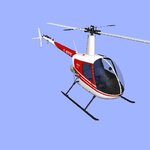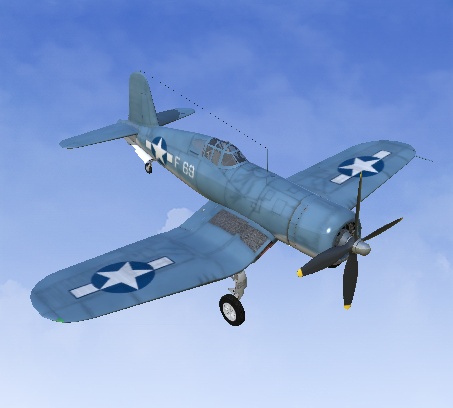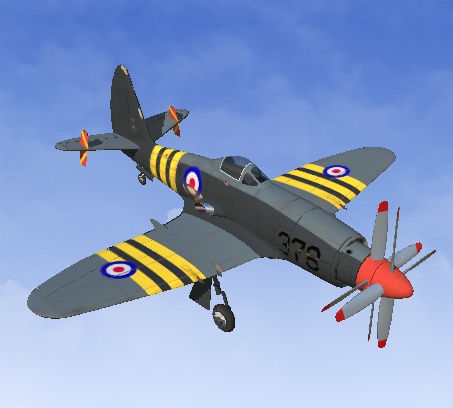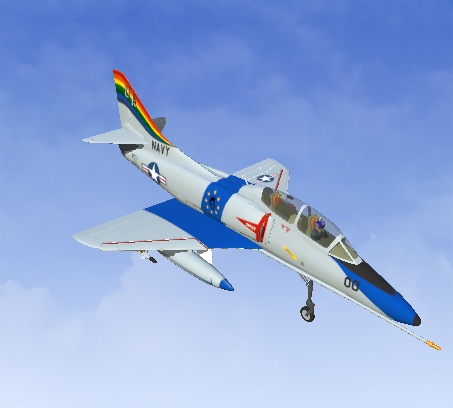Robinson R-22 50% larger; about 1/3.5 scale. Hope you all like it, have fun!
Development
Due to relatively low acquisition and operating costs, the R22 has been popular as a primary rotorcraft trainer around the world and as a livestock management tool on large ranches in North America and cattle stations in Australia. The R22 has a very low inertia rotor system and the control inputs are operated directly by push rods with no hydraulic assistance. Thus, the flight controls are very sensitive and require a light touch to avoid over correcting. A student that masters an R22 generally does not have a problem transitioning to a heavier helicopter.
[edit] Design
Robinson R22 hovering
Robinson R22 hovering
The R-22 is a single-engined helicopter with a semi-rigid two-bladed main rotor and a two-bladed tail rotor. The main rotor provides a teetering hinge and two coning hinges. The tail rotor provides only a teetering hinge.
The normal production variant has skid landing gear. The Mariner version provided floats. Wheeled gear is not available.
The basic structure is welded chrome moly tubing. The forward fuselage is made of fiberglass and aluminum with a Plexiglas canopy. The tail cone, vertical and horizontal stabilizers are aluminum. It has an enclosed cabin with side-by-side seating for a pilot and passenger. The doors may be removed for flight.
The first version was produced as the R22, followed by the R22 HP, R22 Alpha, R22 Beta and R22 Beta II. Superficially, the machines look similar. The R22 HP was fitted with a 160 bhp Lycoming 0-320-B2C engine, an increase of 10 bhp over the original R22. The landing skid assembly on the R22 Alpha was modified by extending the rear struts, giving it a slightly nose-down attitude on the ground and better matching its attitude in a low altitude hover. The R22 Beta added an engine speed governor, rotor brake and auxiliary fuel tank. It has been offered as an instrument trainer version, with optional fixed floats as the R22 Mariner, and other special configurations for police work, electronic news gathering, and so on. Only the basic skid style is currently being sold. The R44 is available as the Clipper with floats, and as police and electronics news configurations.
[edit] Controls
Instead of a floor-mounted cyclic stick between the pilot's knees, the R22 uses a unique teetering "T-Bar" control connected to a stick that emerges from the console between the seats. This makes it easier for occupants to enter and exit the cabin and reduces chances for injury in the event of a hard landing. The teeter bar has a hand grip on both sides that hangs down between the pilots legs. Thus, if teetered to the right, the right side pilot would be flying and the left grip would be about 12 inches above the left pilot's lap. R22 flight instructors quickly learn how to fly with their hand in the air. The left part of the bar and left tail rotor pedals can be removed if the left seat occupant is a non-pilot or needs the room for technical or observer duties.
The helicopter rotor system consists of a two-bladed main rotor and two-bladed anti-torque rotor on the tail, each equipped with a teetering hinge. The main rotor is equipped with two coning hinges. Collective and cyclic pitch inputs to the main rotor are transmitted through pushrods and a conventional swashplate mechanism. Control inputs to the tail rotor are transmitted through a single pushrod inside the aluminum tail cone.
To ease the pilot's workload, a mechanical throttle correlator adjusts the throttle as the collective pitch control is raised or lowered. The pilot only needs to make small adjustments by twisting the throttle grip on the collective throughout the flight regime. Later models are also equipped with an electronic governor which works to maintain RPM within normal operating limits (between 97 and 104% RPM); the governor is only active when the engine is running above 80% RPM, and is most effective in normal flight conditions.[2]
[edit] Powerplant
The R22 uses a horizontally mounted Lycoming O-320 (O-360-J2A on the Beta II), four-cylinder, air-cooled, normally-aspirated, carburetor-equipped piston engine, fueled with 100LL grade aviation gasoline. Cooling is provided through a direct drive squirrel-cage blower. At sea level it is capable of producing more power than the transmission and rotor system can safely handle, and to ensure maximum engine and transmission life the O360 must be derated, or operated at less than maximum power. As the air becomes thinner with increasing altitude, maximum available horse power decreases, reaching a point where the throttle is completely open and rotor RPM is controlled by collective position. By derating the engine at sea level, the R22 achieves acceptable high-altitude performance without use of supercharging or turbocharging, thus saving the complexity, unreliability, and shortened engine life of a turbo charged system.
A carburetor is used to provide the air-fuel mixture. Carbureted engines are susceptible to carburetor icing, a condition most likely to occur in the R22 in conditions of low (-15°C to 5°C) outside air temperature, high humidity, and low power settings, leading to loss of engine power. A carburetor heat control is available to supply heated air to the carburetor; this can prevent or cure icing, but also causes a reduction in engine power output because the hot air is less dense. The R22 employs a carburetor air temperature gauge, marked to indicate temperatures conducive to icing. The Beta II version of the R22 also includes a "carburetor heat assist" which automatically applies carburetor heat when the collective is lowered below a certain point. Carburetor heat is required below 18" manifold pressure to prevent icing around the butterfly from the pressure drop at that point.
Power is transmitted from the engine to the rotor system through a drive belt. Originally, the R22 used separate v-belts. This system proved problematic, as belt length variations due to manufacturing tolerances caused some belts to be overstressed and break. The problem was solved by replacing the individual belts with a single multi-v belt, running on matching multi-groove sheaves. The upper driven sheave is mounted on the tail rotor drive shaft next to a flexible coupling and can be moved relative to the engine-mounted driving sheave by means of a small electric gear motor. During shutdown, the gear motor is used to lower the top sheave to loosen the drive belts. For startup, the engine is started with the belts loose, allowing the engine to run without spinning the rotor system. Immediately after engine start, the clutch switch located in the cockpit is closed by the pilot, powering the gear motor to slowly move the top sheave up to flight position which tightens the belts. The gear motor is thereafter controlled by a pressure-sensing switch, automatically maintaining proper belt tension during flight as the belts warm up and stretch. The tail rotor drive shaft also turns the main transmission, delivering power to the main rotor shaft through a pair of spiral bevel gears.
The top sheave has an over-running clutch built in to the middle to allow the rotor system to continue to rotate in the event the engine stops. This allows the R22 to enter auto rotation and land in a controlled manner. Because the main rotor has very little mass and resulting inertia, auto rotations in an R22 are exciting at best and require careful and proper execution to assure a successful outcome. Much time is spent in training practicing various types of auto rotation. Target speed in an auto rotation is 65KTs and the glide angle is approximately 4:1.
[edit] Service life
After 2200 hours of flight time, the R22 must undergo an extensive overhaul performed by the Robinson factory in Torrance, California, or a factory authorized service center in which many of the critical components of the helicopter are checked and replaced. After 4400 hours of flight the R22 undergoes an even more extensive overhaul, and is considered to be a "new" helicopter once the overhaul is completed.
Specifications (R22)
Data from Robinson R22 Pilot's Operating Handbook.[2] Current versions of the R22 vary slightly.
General characteristics
* Crew: 2
* Length: 28 ft 8 in (8.7 m)
* Rotor diameter: 25 ft 4 in (7.7 m)
* Height: 8 ft 11 in (2.7 m)
* Disc area: 497 ft² (46.2 m²)
* Empty weight: 796 lb (389 kg)
* Loaded weight: 920 lb (417 kg)
* Max takeoff weight: 1,370 lb (635 kg)
* Powerplant: 1× Lycoming O-320-A2B or -A2C flat 4 piston engine, 124 hp (93 kW)
* Main tank total capacity: 19.8 US gallons (75 liters)
* Main tank usable capacity: 19.2 US gallons (73 liters)
* Optional aux tank total capacity: 10.9 US gallons (41 liters)
* Optional aux tank usable capacity: 10.5 US gallons (40 liters)
Performance
* Never exceed speed: 102 knots
* Range: 240 mi (386 km)
* Service ceiling 14,000 ft (4,267 m)
* Rate of climb: 1,200 ft/min (6.1 m/s)
* Disc loading: 2.61 lb/ft² (13.7 kg/m²)
* Power/mass: 0.095 hp/lb (0.147 kW/kg)
* Endurance: approx. 2 hours, with 30-minute reserve
Wikipedia
Development
Due to relatively low acquisition and operating costs, the R22 has been popular as a primary rotorcraft trainer around the world and as a livestock management tool on large ranches in North America and cattle stations in Australia. The R22 has a very low inertia rotor system and the control inputs are operated directly by push rods with no hydraulic assistance. Thus, the flight controls are very sensitive and require a light touch to avoid over correcting. A student that masters an R22 generally does not have a problem transitioning to a heavier helicopter.
[edit] Design
Robinson R22 hovering
Robinson R22 hovering
The R-22 is a single-engined helicopter with a semi-rigid two-bladed main rotor and a two-bladed tail rotor. The main rotor provides a teetering hinge and two coning hinges. The tail rotor provides only a teetering hinge.
The normal production variant has skid landing gear. The Mariner version provided floats. Wheeled gear is not available.
The basic structure is welded chrome moly tubing. The forward fuselage is made of fiberglass and aluminum with a Plexiglas canopy. The tail cone, vertical and horizontal stabilizers are aluminum. It has an enclosed cabin with side-by-side seating for a pilot and passenger. The doors may be removed for flight.
The first version was produced as the R22, followed by the R22 HP, R22 Alpha, R22 Beta and R22 Beta II. Superficially, the machines look similar. The R22 HP was fitted with a 160 bhp Lycoming 0-320-B2C engine, an increase of 10 bhp over the original R22. The landing skid assembly on the R22 Alpha was modified by extending the rear struts, giving it a slightly nose-down attitude on the ground and better matching its attitude in a low altitude hover. The R22 Beta added an engine speed governor, rotor brake and auxiliary fuel tank. It has been offered as an instrument trainer version, with optional fixed floats as the R22 Mariner, and other special configurations for police work, electronic news gathering, and so on. Only the basic skid style is currently being sold. The R44 is available as the Clipper with floats, and as police and electronics news configurations.
[edit] Controls
Instead of a floor-mounted cyclic stick between the pilot's knees, the R22 uses a unique teetering "T-Bar" control connected to a stick that emerges from the console between the seats. This makes it easier for occupants to enter and exit the cabin and reduces chances for injury in the event of a hard landing. The teeter bar has a hand grip on both sides that hangs down between the pilots legs. Thus, if teetered to the right, the right side pilot would be flying and the left grip would be about 12 inches above the left pilot's lap. R22 flight instructors quickly learn how to fly with their hand in the air. The left part of the bar and left tail rotor pedals can be removed if the left seat occupant is a non-pilot or needs the room for technical or observer duties.
The helicopter rotor system consists of a two-bladed main rotor and two-bladed anti-torque rotor on the tail, each equipped with a teetering hinge. The main rotor is equipped with two coning hinges. Collective and cyclic pitch inputs to the main rotor are transmitted through pushrods and a conventional swashplate mechanism. Control inputs to the tail rotor are transmitted through a single pushrod inside the aluminum tail cone.
To ease the pilot's workload, a mechanical throttle correlator adjusts the throttle as the collective pitch control is raised or lowered. The pilot only needs to make small adjustments by twisting the throttle grip on the collective throughout the flight regime. Later models are also equipped with an electronic governor which works to maintain RPM within normal operating limits (between 97 and 104% RPM); the governor is only active when the engine is running above 80% RPM, and is most effective in normal flight conditions.[2]
[edit] Powerplant
The R22 uses a horizontally mounted Lycoming O-320 (O-360-J2A on the Beta II), four-cylinder, air-cooled, normally-aspirated, carburetor-equipped piston engine, fueled with 100LL grade aviation gasoline. Cooling is provided through a direct drive squirrel-cage blower. At sea level it is capable of producing more power than the transmission and rotor system can safely handle, and to ensure maximum engine and transmission life the O360 must be derated, or operated at less than maximum power. As the air becomes thinner with increasing altitude, maximum available horse power decreases, reaching a point where the throttle is completely open and rotor RPM is controlled by collective position. By derating the engine at sea level, the R22 achieves acceptable high-altitude performance without use of supercharging or turbocharging, thus saving the complexity, unreliability, and shortened engine life of a turbo charged system.
A carburetor is used to provide the air-fuel mixture. Carbureted engines are susceptible to carburetor icing, a condition most likely to occur in the R22 in conditions of low (-15°C to 5°C) outside air temperature, high humidity, and low power settings, leading to loss of engine power. A carburetor heat control is available to supply heated air to the carburetor; this can prevent or cure icing, but also causes a reduction in engine power output because the hot air is less dense. The R22 employs a carburetor air temperature gauge, marked to indicate temperatures conducive to icing. The Beta II version of the R22 also includes a "carburetor heat assist" which automatically applies carburetor heat when the collective is lowered below a certain point. Carburetor heat is required below 18" manifold pressure to prevent icing around the butterfly from the pressure drop at that point.
Power is transmitted from the engine to the rotor system through a drive belt. Originally, the R22 used separate v-belts. This system proved problematic, as belt length variations due to manufacturing tolerances caused some belts to be overstressed and break. The problem was solved by replacing the individual belts with a single multi-v belt, running on matching multi-groove sheaves. The upper driven sheave is mounted on the tail rotor drive shaft next to a flexible coupling and can be moved relative to the engine-mounted driving sheave by means of a small electric gear motor. During shutdown, the gear motor is used to lower the top sheave to loosen the drive belts. For startup, the engine is started with the belts loose, allowing the engine to run without spinning the rotor system. Immediately after engine start, the clutch switch located in the cockpit is closed by the pilot, powering the gear motor to slowly move the top sheave up to flight position which tightens the belts. The gear motor is thereafter controlled by a pressure-sensing switch, automatically maintaining proper belt tension during flight as the belts warm up and stretch. The tail rotor drive shaft also turns the main transmission, delivering power to the main rotor shaft through a pair of spiral bevel gears.
The top sheave has an over-running clutch built in to the middle to allow the rotor system to continue to rotate in the event the engine stops. This allows the R22 to enter auto rotation and land in a controlled manner. Because the main rotor has very little mass and resulting inertia, auto rotations in an R22 are exciting at best and require careful and proper execution to assure a successful outcome. Much time is spent in training practicing various types of auto rotation. Target speed in an auto rotation is 65KTs and the glide angle is approximately 4:1.
[edit] Service life
After 2200 hours of flight time, the R22 must undergo an extensive overhaul performed by the Robinson factory in Torrance, California, or a factory authorized service center in which many of the critical components of the helicopter are checked and replaced. After 4400 hours of flight the R22 undergoes an even more extensive overhaul, and is considered to be a "new" helicopter once the overhaul is completed.
Specifications (R22)
Data from Robinson R22 Pilot's Operating Handbook.[2] Current versions of the R22 vary slightly.
General characteristics
* Crew: 2
* Length: 28 ft 8 in (8.7 m)
* Rotor diameter: 25 ft 4 in (7.7 m)
* Height: 8 ft 11 in (2.7 m)
* Disc area: 497 ft² (46.2 m²)
* Empty weight: 796 lb (389 kg)
* Loaded weight: 920 lb (417 kg)
* Max takeoff weight: 1,370 lb (635 kg)
* Powerplant: 1× Lycoming O-320-A2B or -A2C flat 4 piston engine, 124 hp (93 kW)
* Main tank total capacity: 19.8 US gallons (75 liters)
* Main tank usable capacity: 19.2 US gallons (73 liters)
* Optional aux tank total capacity: 10.9 US gallons (41 liters)
* Optional aux tank usable capacity: 10.5 US gallons (40 liters)
Performance
* Never exceed speed: 102 knots
* Range: 240 mi (386 km)
* Service ceiling 14,000 ft (4,267 m)
* Rate of climb: 1,200 ft/min (6.1 m/s)
* Disc loading: 2.61 lb/ft² (13.7 kg/m²)
* Power/mass: 0.095 hp/lb (0.147 kW/kg)
* Endurance: approx. 2 hours, with 30-minute reserve
Wikipedia







